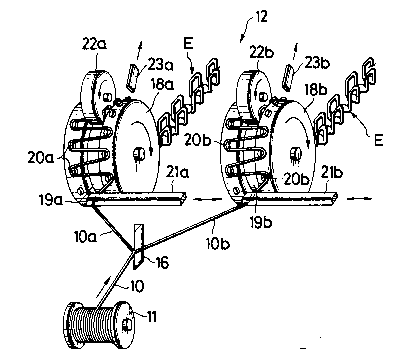Une partie des informations de ce site Web a été fournie par des sources externes. Le gouvernement du Canada n'assume aucune responsabilité concernant la précision, l'actualité ou la fiabilité des informations fournies par les sources externes. Les utilisateurs qui désirent employer cette information devraient consulter directement la source des informations. Le contenu fourni par les sources externes n'est pas assujetti aux exigences sur les langues officielles, la protection des renseignements personnels et l'accessibilité.
L'apparition de différences dans le texte et l'image des Revendications et de l'Abrégé dépend du moment auquel le document est publié. Les textes des Revendications et de l'Abrégé sont affichés :
| (12) Brevet: | (11) CA 2005170 |
|---|---|
| (54) Titre français: | METHODE DE FORMATION D'UNE CHAINE DE COUPLEURS CROISES POUR FERMETURE-ECLAIR |
| (54) Titre anglais: | METHOD OF FORMING A CHAIN OF MEANDERING COUPLING ELEMENTS FOR SLIDE FASTENERS |
| Statut: | Périmé et au-delà du délai pour l’annulation |
| (51) Classification internationale des brevets (CIB): |
|
|---|---|
| (72) Inventeurs : |
|
| (73) Titulaires : |
|
| (71) Demandeurs : |
|
| (74) Agent: | GOWLING WLG (CANADA) LLP |
| (74) Co-agent: | |
| (45) Délivré: | 1995-03-28 |
| (22) Date de dépôt: | 1989-12-11 |
| (41) Mise à la disponibilité du public: | 1990-06-20 |
| Requête d'examen: | 1989-12-11 |
| Licence disponible: | S.O. |
| Cédé au domaine public: | S.O. |
| (25) Langue des documents déposés: | Anglais |
| Traité de coopération en matière de brevets (PCT): | Non |
|---|
| (30) Données de priorité de la demande: | ||||||
|---|---|---|---|---|---|---|
|
A method of forming a chain of meandering or zig-zag
coupling elements for slide fasteners comprises dividing or
bifurcating a continuous length of substantially
cross-sectionally circular monofilamentary material axially
into identical halves of substantially semi-circular
cross-section immediately prior to introduction to a forming
apparatus. The identical halves may be provisionally joined
together to provide a cross-sectionally circular
monofilament and divided back into respective halves
immediately prior to formation thereof into respective rows
of coupling elements for slide fasteners.
Note : Les revendications sont présentées dans la langue officielle dans laquelle elles ont été soumises.
Note : Les descriptions sont présentées dans la langue officielle dans laquelle elles ont été soumises.

2024-08-01 : Dans le cadre de la transition vers les Brevets de nouvelle génération (BNG), la base de données sur les brevets canadiens (BDBC) contient désormais un Historique d'événement plus détaillé, qui reproduit le Journal des événements de notre nouvelle solution interne.
Veuillez noter que les événements débutant par « Inactive : » se réfèrent à des événements qui ne sont plus utilisés dans notre nouvelle solution interne.
Pour une meilleure compréhension de l'état de la demande ou brevet qui figure sur cette page, la rubrique Mise en garde , et les descriptions de Brevet , Historique d'événement , Taxes périodiques et Historique des paiements devraient être consultées.
| Description | Date |
|---|---|
| Inactive : CIB de MCD | 2006-03-11 |
| Inactive : CIB de MCD | 2006-03-11 |
| Inactive : CIB de MCD | 2006-03-11 |
| Inactive : CIB de MCD | 2006-03-11 |
| Le délai pour l'annulation est expiré | 1998-12-11 |
| Lettre envoyée | 1997-12-11 |
| Accordé par délivrance | 1995-03-28 |
| Demande publiée (accessible au public) | 1990-06-20 |
| Toutes les exigences pour l'examen - jugée conforme | 1989-12-11 |
| Exigences pour une requête d'examen - jugée conforme | 1989-12-11 |
Il n'y a pas d'historique d'abandonnement
Les titulaires actuels et antérieures au dossier sont affichés en ordre alphabétique.
| Titulaires actuels au dossier |
|---|
| YKK CORPORATION |
| Titulaires antérieures au dossier |
|---|
| TAKEO FUKUROI |